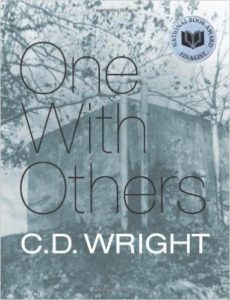One With Others
 by C.D. Wright,
by C.D. Wright,
Copper Canyon, 2010,
168 pages, paper, $18.00,
ISBN: 978–1–55659–388–8
Buy the Book
C.D. Wright’s One With Others, her portrait of one spitfire white woman in Civil Rights – era Arkansas, is not, she advises, a work of history: Rather, it is a “welter of associations,” a “report full of holes.” In this riddling of documentary, memory, and meditation, Wright returns to her native home as poet, investigator, and witness, to conjure her old mentor and friend V, an iconoclastic firebrand for literature and civil rights who in 1969 crossed the color line to join a civil rights march, and was driven out of town forever. Through interviews, news clippings, and her own recollections, Wright has crafted a book of verse with the momentum of fiction, by turns elegiac, slyly funny, and horrifying, in homage to V, a vibrant moral and cultural anomaly of her time and place.
That time and place is provincial Big Tree, Arkansas, smoldering with racial strife at a time of similar conflagrations across the nation. Wright calls it up through the words of radio ministers and the local veterinarian, with jokes and Dear Abby columns. She evokes it in its smells (“The faint cut of walnuts in the
grass. . . . The pulled – barbecue evening.”); its grocery prices (“A Whole fryer is 59¢.”; “Two pounds of Oleo, 25¢”); and the headlines (“Los Angeles enters its sixth day of rioting, 32 dead.”) She interviews the black man, a former state senator, who was beaten “by the sheriff who kept a man’s testicles in a jar on his desk until the word got around.”
As a woman and a homegrown intellectual in this world, V is fierce and ever – seething: “She woke up in a housebound rage, my friend V,” Wright tells us. “Changed diapers. Played poker. Drank bourbon. . . . Yeats she knew well enough to wield as a weapon.” V emerges through an array of recollections. From a friend: “Dragged her sewing machine to the porch because she did not want to have to look at it.” An old neighbor: “Oh yeah, I remember her, she celebrated all her kids’ birthdays on the same day.” Wright on her talk with another neighbor: “Flat out, she says, She didn’t trust me and I didn’t trust her. / Then she surprised me, saying, She was right. We were wrong.” The act that shunt V from much of the white community was to join a black organizer Wright refers to as The Man Imported from Memphis (aka “The Invader”) in The March Against Fear, a decision that got her her own headline: “WHITE WOMAN BACKS NEGROES, LOSES FRIENDS.”
Wright reveals V’s story and that of the March through a range of voices — friends from before and after her banishment, activists, and observers. Her storytelling is vertiginously non – linear, in fragments, verse, and prose poems that zoom in and out of time, that circle and refrain. The name of a movie playing in a segregated theater is forgotten one moment, but remembered some pages later; a radio preacher is possibly misheard (“Now get in that goddamn water and swim with the rest of them.”) Wright’s work is rich in changing tenses and shifts in narrators; her own voice withdraws for a time, then returns with an intimate lurch. Here, telling of V’s car blown up after the March: “She had just begun to drive, I mean she just learned to drive and she had many miles to go. Then whoa, Gentle Reader, no more car.” Wright’s piecemeal, circuitous narrative evokes the very shape and rhythm of memory, and the investigation of memory.
That investigation sometimes lands in a searing philosophy of the South’s ills. On the nature of institutionalized bigotry: “King called ‘it’ a disease, segregation. [sounds contagious] / It’s cradle work, is what it is. It begins before the quickening.” And on the emotional contortions of the regularly wronged:
. . . those so grievously harmed, who do the forgiving, do
so, that they not be deformed by the lie, must call on
reserves not meant to be tapped except for a
once – in – a – lifetime crisis. .. . .
But in this case, the reserves are needed every day, every hour of every day, because the warp is everywhere. . . . It is, in fact, the law.
By a gradual accumulation of glints and fragments, Wright also reveals a culture and V over time, the grown children of Big Tree and V ever – rebellious in 2004, on her deathbed in a one – room Hell’s Kitchen apartment. In these moments, there is the temptation to find relief in the contemporary, in having caught up in time to a saner, reason – driven present, the after to the before. But in Wright’s magnificent, important “welter of associations,” in the jukeboxes, radio, and people she hears in today’s Big Tree, there is a stark reminder that history’s shifts, its remembering and forgetting, its outrages, are inextricable from a modernity that’s anything but finished:
Sound of the future, how close
to the sound of the old. . . .
— Megan Grumbling

